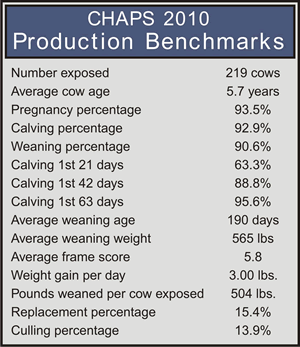
Kris Ringwall
Beef Talk
2010 CHAPS production benchmarks are in.
Each year, the North Dakota Beef Cattle Improvement Association (NDBCIA) summarizes the average performance of beef cattle herds that are utilizing the CHAPS programs. The NDBCIA has been keeping records since 1963 and presents these annual evaluations as five-year rolling benchmark values for average herd performance for several traits.
The purpose of the NDBCIA is the improvement of beef cattle by primarily focusing on genetic improvement and being very cognizant of the yearly management that is involved in a beef cattle operation.
In reality, the need is to grow
profitable cattle
that a producer can appreciate and
still meet
industry needs.Through the years, individual producers compare their herd values to the overall averages. This allows producers to evaluate individual herd performance, discuss it and, perhaps, make changes. Much like setting personal goals, the group benchmarks allow producers to set goals and have a set of numbers as a guide to their goals.
Although there is not an absolute right answer, an appreciation of what others are doing helps producers evaluate their own situation. If we never know what others are doing, we can stray.
Data trends also can be evaluated. For example, reviewing the yearly values for cow age, the average cow was a little younger in the CHAPS data set in 2009 than in 2005, which was the first year of the rolling five-year benchmark values.
The calves actually were a litter bit older in 2009 at weaning than in 2005. Interestingly, reproductive values dropped a little and calf death loss was up in 2009 vs. any of the previous four years.
The pounds weaned per cow exposed are still holding above 500 pounds (lb.). Growth and reproduction tend to be the mainstay of the beef business, so those involved in the NDBCIA CHAPS program are excelling.
Generally, growth is thought of as the average daily gain in the feedlot business and is a major component of profit for the cow-calf producer. The typical average daily gain for CHAPS calves is 2.52 lb. In terms of the cow-calf producer, growth has the same impact because the total pounds times the price contributes in a major way to gross income.
 The value of the calf is determined principally by weight, which is in contrast to the feedlot calf where the cow also must carry the burden of expenses for cows that do not produce a calf.
The value of the calf is determined principally by weight, which is in contrast to the feedlot calf where the cow also must carry the burden of expenses for cows that do not produce a calf.
Granted, the open cow (typical CHAPS open cow value is 7.2%) has a market value, but that value will not cover the cost of replacing the cow. Therefore, each cow in the herd has to produce to cover her annual expenses and for nonproducing cows. The better the herd reproduction, the more likely the herd can cover expenses.
As the NDBCIA evaluates traits to measure cow performance, the trait "pounds weaned per cow exposed to the bull" is a trait that factors in both management and genetics. This is just an example of the many traits NDBCIA monitors through the use of the CHAPS program.
Additional traits follow along with the current benchmark. The average CHAPS producer exposed 219 cows to bulls. The cows had an average age of 5.7 years. Of the 219 cows exposed to the bull, 93.5% were pregnant in the fall, 92.9% calved in the spring and 90.6% weaned a calf in the fall.
During the calving season, 63.3% calved during the first 21 days, 88.8% during the first 42 days and 95.6% within the first 63 days of the calving season.
The weaning age was 190 days, the weight was 565 lb. and the frame score was 5.8. These growth numbers translated into 3 lb. of weight gain per day of age and a 637-lb. adjusted 205-day weight. For every cow exposed, CHAPS producers weaned 504 lb. of calf.
Knowing these numbers allows for appropriate modification through management or genetics. There are no absolute answers to what a particular ranch should produce. The academic answer is optimization.
 In reality, the need is to grow profitable cattle that a producer can appreciate and still meet industry needs. Each producer must answer the question, but the answer must be based on data that ultimately tells you if you are in the game.
In reality, the need is to grow profitable cattle that a producer can appreciate and still meet industry needs. Each producer must answer the question, but the answer must be based on data that ultimately tells you if you are in the game.
May you find all your ear tags.
Your comments are always welcome at www.BeefTalk.com. For more information, contact the NDBCIA Office, 1041 State Ave., Dickinson, ND 58601, or go to www.CHAPS2000.com on the Internet.




